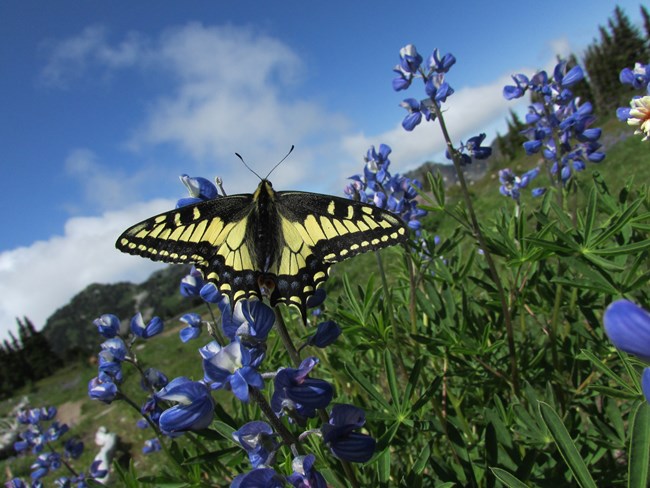
Subalpine and Alpine ecosystems are extremely sensitive to the effects of climate change because species in these areas are adapted to long winters and short, mild growing seasons. Butterflies and plants are sensitive to changes in temperature and precipitation, and by monitoring them they may give us an early warning into future ecosystem changes. Park scientists are seeking the help of Citizen Scientists to monitor butterfly and plant phenology along ten survey routes in two National Parks, and two National Forests.
Who should volunteer?
Do you love to go hiking through meadows filled with wildflowers? Would you like to know more about the plants and butterflies you encounter on your hikes? Would you like to play a role in the ongoing protection of your National Parks? If you answered ‘yes’ to any or all of these questions, this project is for you!
Tell me more!
Check out our project summary and our frequently asked questions below.
Frequently Asked Questions:
- How long does each survey take?
- An average survey takes about two hours. This can fluctuate depending on how active the butterflies are, and the speed in which the plant phenology survey is completed. In addition to the survey time, you will need to allow time for the hike to and from the parking lot to the start of the survey route.
- How much time do I need to commit to?
- There is no minimum amount of time you have to commit to volunteering. If you are only able to volunteer for one day, you will still be a great benefit to the program. Some volunteers choose to volunteer once a week, and some volunteer only as they are able to.
- Do I need to have any prior knowledge or experience?
- No! All you need is the willingness to learn. You will be accompanied by a scientist who will help and explain how to identify the butterflies and plants.
- Is there training?
- There will be a one day orientation/training at the beginning of the summer to familiarize you with survey protocol. If you are unable to make this training, do not despair! Training will be provided the first day you volunteer.
- How strenuous is the hiking?
- The distance and difficulty of the hikes vary greatly between each survey route. The easiest being about one mile round trip, to the most difficult being approximately 7 miles round trip. All hikes will include some elevation gain!
- What do I need to bring?
- You do not need to bring any equipment relating to the surveys. You do need to bring the essentials for any hiker: sturdy shoes, water, lunch, and appropriate clothing for the weather. You may want to bring trekking poles, sunglasses, and a camera to take pictures of the stunning scenery and beautiful butterflies!
- Is the program catch-and-release?
- Yes. Butterflies will be captured in order to make an identification to species level. After they are identified, they are sent on their merry way.
- Where and when does it take place?
- Surveys are completed during the summer season, Monday through Friday, when the survey routes are free of snow. The ten permanent survey routes are located within Mount Rainier and North Cascades National Parks, and Mount Baker-Snoqualmie and Okanogan-Wenatchee National Forests. It is your choice as to which survey route or survey routes you would like to survey.
- Do volunteers work alone?
- Volunteers always work with a park scientist or an experienced volunteer. Work groups usually consist of two to four people.
- Do you have housing/ Am I expected to camp?
- Most volunteers drive in for the day. However, if it is more convenient for you to camp before or after the survey, a free campsite will be provided for you in a front-country campground for one or two nights. Unfortunately there is no housing available other than camping.
- How do I sign up?
- Contact our project lead to choose a survey route and a start date. You will be signed up as a volunteer by completing a sign-up sheet, and can do this either at the training or on your first day of volunteering.
Last updated: May 14, 2018
